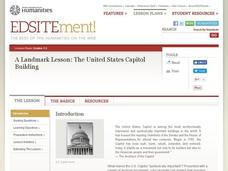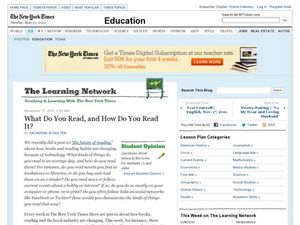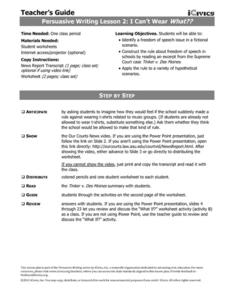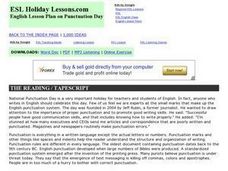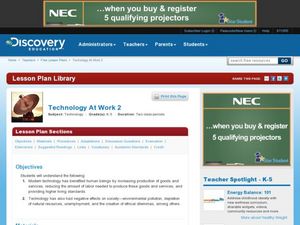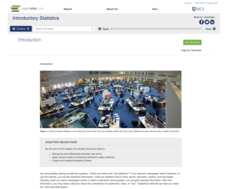Curated OER
What Time Is It?
Take down that digital clock! Scholars practice reading an analog clock face with the minute hand on various quarter-hour increments. They write the correct time below nine clocks, each of which have the hour hand in green and the minute...
Curated OER
How Much is it Worth?
Money makes everything a little more fun for your mathematicians! Show them how they can implement their addition skills in the real world using this worksheet. Scholars examine six sets of coins, which are photographed. They include...
Curated OER
Find the Prime Factors
Find prime factors can be grasped through visualization, which is exaclty what these digrams will help your learners do. For each, they examine a double-digit number and several paths connecting from it. They fill in the factors, prime...
Curated OER
Kyoto Protocol
In this environment worksheet, students read an article about setting up the Kyoto Protocol, an international treaty. They identify the meaning of human environment and what the Earth's greenhouse effect is. Students also explain the...
Curated OER
Professor of Ice
In this environment experiment worksheet, high schoolers complete 3 experiments using ice. First they label each experiment and respond to the four questions given. Then students do the 3 experiments as stated, considering what the...
Curated OER
Aerial Photographs
In this geography worksheet, high schoolers read an excerpt about aerial photographs and how they are taken. Then they identify shape, size, tone, shadows, and other hints that might be seen. Finally, students respond to 5 short answer...
Curated OER
A Landmark Lesson: The United States Capitol Building
Students study the events in American history that affected the US Capitol Building. They name activities that happen in and around the Capitol by looking at primary source documents that are available online.
Curated OER
Student Opinion: What Do You Read, and How Do You Read It?
Stimulate discussion with this brief article and series of questions related to reading habits. This resource, from the New York Times' The Learning Network, asks learners to comment on their own reading habits. You could have your class...
Curated OER
Global Hunger and Malnutrition
Is there a difference between hunger and malnutrtion? Is this a problem only in third world countries? How does hunger and malnutrition affect the community? Why do these problems exist when the world produces enough food to feed...
Curated OER
Numbers in Spanish
Spanish learners can start with uno, dos, y tres and move all the way up into the millions and trillions on their way to learning all the numbers. The webpage includes information on cardinal numbers, ordinal numbers, fractions, and...
iCivics
I Can’t Wear What?
Can schools ban t-shirts picturing musical groups or bands? Your young citizens will find out with this resource, which includes a summary of a United States Supreme Court case from the 1960s about a similar dispute over students wearing...
All About Reading
Pirate Dictionary
Shiver me timbers, this here resource is a great way to teach young landlubbers to speak the language of the briny deep. Including over 30 different words and phrases, complete with definitions and guide words, this dictionary will have...
Curated OER
Talk to Mom, Dad, Sister Worksheets
Help learners with special needs recognize the interests of their family members and build a foundation for conversation practice using worksheet activities and social prompts.
Lerner Publishing
Teaching Vowel Combinations
Need some fun activities to augment your lessons on vowel patterns and phonemic awareness? Peruse a series of worksheets designed to help little ones with their early reading skills.
Curated OER
Letter Fans (Can Customize)
Create a set of letter fans for your learners based on the letters or blended sounds that you're working on in your class. The printable allows you to customize the particular letters on the fan, making the activity applicable to any...
Curated OER
A Picture Is Worth a Thousand Words
Seventh graders create a multimedia, image only ad campaign on a contemporary controversial issue. They base their public service announcement, Powerpoint presentation, Web page, or video on methods used by Martin Luther during the...
Curated OER
Julie Chen: Thinking Outside the Book
Students create an original art book after studying nontraditional boomaking. In this visual arts lesson, students watch a video on the work of Julie Chen and discuss the concept of books as three-dimensional art. Then students are asked...
Curated OER
Westward Expansion
Students explore the Westward Expansion Movement of U.S. history. In this Westward movement lesson, students use primary and secondary source documents research personal accounts of those who travelled west during the era....
Curated OER
Who Started World War I?
Students debate which power was responsible for the outbreak of World War I. In this cause and effects lesson, students research the causes of the outbreak of World War I on ProQuest in preparation for a (limited) reenactment of the...
Curated OER
Punctuation Day
In this Punctuation Day learning exercise, students complete activities such as reading a passage, phrase matching, fill in the blanks, choose the correct word, multiple choice, spelling, sequencing, scrambled sentences, asking...
Curated OER
Technology at Work 2
Learners discover the positive and negative effects of technology. In this technology lesson, students give examples of technology advances from the past few years. Learners get into groups and debate whether a particular item has hurt...
Curated OER
The History of Writing
The history of written communication can be an interesting addition to history lessons.
Breaking News English
More People to Stick to New Year's Resolutions
What makes a good New Year's resolution? Practice goal-setting and reading comprehension with a set of language arts activities. English learners work on cloze passages, synonym matches, interviewing exercises, and comprehension...
Rice University
Introductory Statistics
Statistically speaking, the content covers several grades. Featuring all of the statistics typically covered in a college-level Statistics course, the expansive content spans from sixth grade on up to high school. Material comes from a...








